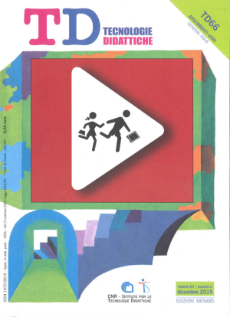"ProgeTTTTare" l'apprendimento collaborativo con T4
Contenuto principale dell'articolo
Abstract
Dettagli dell'articolo
Gli autori che pubblicano su questa rivista accettano le seguenti condizioni:
- Gli autori mantengono i diritti sulla loro opera e cedono alla rivista il diritto di prima pubblicazione dell'opera, contemporaneamente licenziata sotto una Licenza Creative Commons CC BY 4.0 Attribution 4.0 International License.
- Gli autori possono aderire ad altri accordi di licenza non esclusiva per la distribuzione della versione dell'opera pubblicata (es. depositarla in un archivio istituzionale o pubblicarla in una monografia), a patto di indicare che la prima pubblicazione è avvenuta su questa rivista.
- Gli autori possono diffondere la loro opera online (es. in repository istituzionali o nel loro sito web) prima e durante il processo di submission, poiché può portare a scambi produttivi e aumentare le citazioni dell'opera pubblicata (Vedi The effect of Open Access).
Riferimenti bibliografici
Anderson, T., Liam, R., Garrison, D.R., & Archer, W. (2001). Assessing teacher presence in a computer conferencing context. Journal of the Asynchronous Learning Networks , 5 (2), 1-17.
Bell, P. (2004). Promoting students’ argument construction and collaborative debate in the classroom. In M. C. Linn, E. A. Davis & P. Bell (Eds.), Internet environments for science education. Mahwah, NJ, USA: Erlbaum.
Bergin, J., Eckstein, J., Volter, M., Sipos, M., Wallingford, E., Marquardt, K., ... Manns, M. L. (Eds.) (2012). Pedagogical Patterns: Advice For Educators . New York, NY, USA: Joseph Bergin Software Tools.
Cameron, L. (2009). How learning design can illuminate teaching practice. The Future of Learning Design Conference . Retrieved from http://ro.uow.edu.au/fld/09/Program/3
Conole, G. (2010). An overview of design representations. In Dirckinck-Holmfeld, V. Hodgson, C. Jones, M. de Laat, D. McConnell, & T. Ryberg (Eds.), Proceedings of the International Conference on Networked Learning 2010 . Retrieved from http://www.lancs.ac.uk/fss/organisations/netlc /past/nlc2010/abstracts/PDFs/Conole_2.pdf
Conole, G. (2013). Designing for learning in an Open World . New York, NY, USA: Springer.
Demetriadis, S., Dimitriadis, Y. & Fischer, F. (2009). Introduction to the SFC-2009 Workshop. In Proceedings of the workshop Scripted vs. free collaboration: alternatives and paths for adaptable and flexible CS scripted collaboration . Retrieved from http://mlab.csd.auth.gr/cscl2009/SFC- files/SFC-2009-WorkshopProceedings.pdf
Dillenbourg, P. (Ed.) (1999). Collaborative Learning: Cognitive and Computational Approaches. Amsterdam, NL: Pergamon Press.
Dillenbourg, P. (2002). Over-scripting CSCL: The risks of blending collaborative learning with instructional design. In P. A., Kirschner, (Eds.), Three worlds of CSCL. Can we support CSCL (pp. 61-91) . Heerlen, NL: Open Universiteit Nederland.
Dillenbourg, P. & Hong, F. (2008). The Mechanics of Macro Scripts. International Journal of Computer-Supported Collaborative Learning , 3 (1), 5-23.
Dillenbourg, P. & Jermann, P. (2007). Designing Integrative Scripts. In F. Fischer, I. Kollar., H. Mandl and J.M. Haake (Eds.), Scripting Computer-Supported Collaborative Learning Cognitive, Computational and Educational Perspectives (pp.275-301). New York, NY, USA: Springer.
Fischer, F., Kollar, I., Mandl, H. & Haake, J. (Eds.) (2007). Scripting computer-supported collaborative learning: Cognitive, computational and educational perspectives. New York, NY, USA: Springer.
Garrison, D.R., Anderson, T. & Archer, W. (2001). Critical thinking, cognitive presence, and computer conferencing in distance education. American Journal of distance education , 15 (1), 7-23.
Hernández-Leo, D., Villasclaras-Fernández, E. D., Asensio-Pérez, J. I, Dimitriadis, Y., Jorrín- Abellán, I. M., Ruiz-Requies, I. & Rubia-Avi, B. (2006). COLLAGE: A collaborative Learning Design editor based on patterns. Educational Technology & Society , 9 (1), 58-71.
Hewitt, J. (2005). Toward an understanding of how threads die in asynchronous computer conferences. The Journal of the Learning Sciences , 7 (4), 567-589.
Kanuka, H. & Anderson, T. (1999). Using Constructivism in Technology-Mediated Learning: Constructing Order out of the Chaos in the Literature. Radical Pedagogy, 1(2).
Kollar, I., Fischer, F. & Hesse, F. W. (2006). Computer-supported collaboration scripts - a conceptual analysis. Educational Psychology Review, 18(2), 159-185. Retrieved from https://hal.archives-ouvertes.fr/hal-00703937
Koper, R. (2006). Current research in learning design. Educational Technology & Society, 9(1), 13-22.
Liu, C. & Tsai, C. (2008). An analysis of peer interaction patterns as discoursed by on-line small group problem-solving activity. Computers & Education, 50, 627-639.
Palloff, R. M. & Pratt, K. (1999). Building learning communities in cyberspace. San Francisco, CA, USA: Jossey-Bass Publishers.
Pérez-Sanagustín, M., Santos, P., Hernández-Leo, D. & Blat, J. (2012). 4SPPIces: A case study of factors in a scripted collaborative-learning blended course across spatial locations. International Journal of Computer-Supported Collaborative Learning, 7(3), 443-465.
Persico, D. (1997). Methodological constants in courseware design. British Journal of Educational Technology, 28(2), 111-123.
Persico, D. (2013). Dove sta andando la ricerca sul learning design?. TD Tecnologie Didattiche, 21(1), 58-60. Retrieved from http://www.tdjournal.itd.cnr.it/files/pdfarticles/ PDF58/td58_parer.pdf
Persico, D., & Pozzi, F. (2011). Task, Team and Time to structure online collaboration in learning environments. World Journal on Educational Technology, 3(1), 1-15.
Persico, D., Pozzi, F., Anastopoulou, S., Conole, G., Craft, B., Dimitriadis, Y., … Walmsley, H. (2013). Learning design Rashomon I – supporting the design of one lesson through different approaches. Research in Learning Technology, 21, Supplement “The art and science of learning design”. doi:10.3402/rlt.v21i0.20224
Persico, D., Pozzi, F., & Sarti, L. (2009a). Design patterns for monitoring and evaluating CSCL processes. Computers in Human Behavior, 25(5), 1020-1027. Persico D., Pozzi F., Sarti L. (2009b). Fostering collaboration in CSCL. In A. Cartelli & M. Palma (Eds.), Encyclopaedia of Information and Communication Technology, vol. I (pp. 335- 340). Hershey, NY, USA: IGI Global. doi: 10.4018/978-1-59904-845-1.ch044
Persico D., Pozzi F., & Sarti L. (2010). Monitoring collaborative activities in Computer Supported Collaborative Learning. Distance Education, 31(1), 5-22.
Pozzi, F., Asensio-Pérez, J. I., and Persico, D. (2015). The case for multiple representations in the learning design lifecycle. In B. Gros Kinshuk, & M. Maina (Eds.), The architecture of ubiquitous learning: learning designs for emerging pedagogies, 171-196. New York, NY, USA: Springer.
Pozzi, F., Hofmann, L., Persico, D., Stegmann, L., & Fischer, F. (2011). Structuring CSCL through collaborative techniques and scripts. International Journal of Online Pedagogy and Course Design, 1(4), 39-49.
Pozzi, F. & Persico, D. (Eds.) (2011). Techniques for fostering collaboration in online learning communities: theoretical and practical perspectives. Harshey, PA, USA: Information Science Reference - IGI Global.
Pozzi, F., & Persico, D. (2013). Sustaining learning design and pedagogical planning in CSCL. Research in Learning Technology (RiLT) - Supplement 2013, 21: 20224. doi:10.3402/rlt.v21i0.17585.
Pozzi, F., Persico, D., Dimitriadis, Y., Joubert, M., Tissenbaum, M., Tsovaltzi, D., …Wise, A. (2011). Structuring online collaboration through 3Ts: Task, Time and Teams. White Paper at the STELLAR Alpine Rendez-Vous 2011. Retrieved from http://www.telearn.org/warehouse/ARV2011_W hitePaper_StructuringOnlineCollaborationthroug h3Ts_%28006754v1%29.pdf
Ronen, M., Kohen-Vacs, D. & Raz-Fogel, N. (2006). Structuring, Sharing and Reusing Asynchronous Collaborative Pedagogy. International Conference of the Learning Sciences, ICLS 2006, Indiana University, Bloomington, IN, USA.
Rourke, L., Anderson, T., Garrison D.R., & Archer, W. (2007). Assessing social presence in asynchronous text-based computer conferencing. The Journal of Distance Education/Revue de l’Éducation à Distance, 14(2), 50-71.
Scardamalia, M. & Bereiter, C. (1994). Computer support for knowledge-building communities. The Journal of the Learning Sciences, 3(3), 265-283.
The Cognition and Technology Group at Vanderbilt (1991). Some thoughts about constructivism and instructional design. Educational Technology, 31(10), 16-18.
Villasclaras-Fernández, E., Hernández-Leo, D., Asensio-Pérez, J. I., & Dimitriadis, Y. (2013). Web Collage: an implementation of support for assessment design in CSCL macro-scripts. Computers & Education, 67, 79-97.
Weinberger, A., Ertl, B., Fischer, F. & Mandl, H. (2004). Cooperation Scripts for Learning via Web-Based Discussion Boards and Videoconferencing. EARLI SIM 2004, Tubingen. Retrieved from http://www.cs.uu.nl/docs/ vakken/b3elg/literatuur_files/weinberg.pdf
Wessner, M., & Pfister, H.-R. (2001). Group formation in computer-supported collaborative learning. In Proceedings of the 2001 International ACM SIGGROUP Conference on Supporting Group Work, 24-31.

